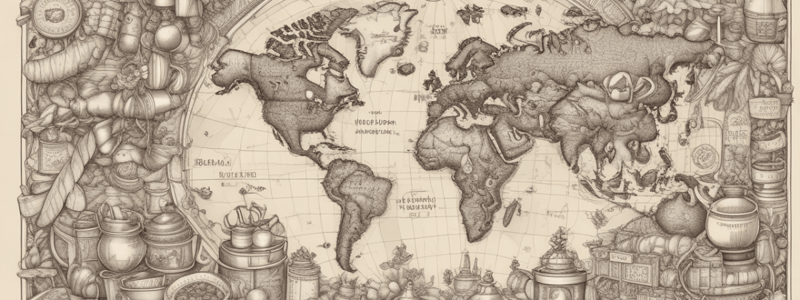Podcast
Questions and Answers
Match the following coffee types with their characteristics:
Match the following coffee types with their characteristics:
Arabica = More expensive, mild and nuanced flavor, grown at high altitudes Robusta = More bitter, higher caffeine content, often used in instant coffee Liberica = Rare, fruity and floral flavor Excelsa = Hybrid of Liberica and Arabica
Match the following coffee roasting methods with their flavor profiles:
Match the following coffee roasting methods with their flavor profiles:
Light roasts = More acidic and fruity Dark roasts = More bitter and caramel-like
Match the following coffee processing methods with their resulting flavors:
Match the following coffee processing methods with their resulting flavors:
Natural = Fruity flavor Washed = Cleaner flavor
Match the following effects of caffeine with their physiological responses:
Match the following effects of caffeine with their physiological responses:
Match the following coffee-related terms with their descriptions:
Match the following coffee-related terms with their descriptions:
Match the following coffee drinks with their characteristics:
Match the following coffee drinks with their characteristics:
Match the following benefits of antioxidants in coffee with their effects:
Match the following benefits of antioxidants in coffee with their effects:
Match the following coffee plant types with their characteristics:
Match the following coffee plant types with their characteristics:
Match the following historical events with their significance in coffee history:
Match the following historical events with their significance in coffee history:
Match the following coffee cultures with their emphasis:
Match the following coffee cultures with their emphasis:
Flashcards are hidden until you start studying
Study Notes
History of Coffee
- Originated in Ethiopia over 1,000 years ago
- Legend has it that a goatherd discovered coffee after noticing his goats became more energetic after eating coffee cherries
- Spread to the Arabian Peninsula, where it was cultivated and traded throughout the Middle East
Coffee Production
- Coffee beans are harvested from coffee plants (Coffea arabica or Coffea canephora)
- Beans are processed through one of two methods:
- Natural: dried in their fruit, resulting in a fruitier flavor
- Washed: pulp and skin removed, resulting in a cleaner flavor
- Roasting:
- Light roasts: more acidic and fruity
- Dark roasts: more bitter and caramel-like
Coffee Types
- Arabica: more expensive, mild and nuanced flavor, grown at high altitudes
- Robusta: more bitter, higher caffeine content, often used in instant coffee
- Liberica: rare, fruity and floral flavor
- Excelsa: hybrid of Liberica and Arabica
Coffee and Health
- Caffeine:
- Stimulates nervous system, increases alertness and energy
- Can improve mental performance and reaction time
- Antioxidants:
- May reduce risk of chronic diseases such as heart disease and cancer
- May improve cognitive function and reduce risk of neurodegenerative diseases
Coffee Culture
- Third wave coffee: focus on high-quality, unique beans and brewing methods
- Coffee houses:
- Historical significance as social gathering spaces
- Modern coffee shops often focus on ambiance and customer experience
- Coffee drinks:
- Espresso: concentrated shot of coffee
- Macchiato: espresso "marked" with milk
- Cappuccino: espresso, steamed milk, and foam
- Latte: espresso and steamed milk
History of Coffee
- Coffee originated in Ethiopia over 1,000 years ago, with a legend suggesting that a goatherd discovered its energizing effects on his goats.
- From Ethiopia, coffee spread to the Arabian Peninsula, where it was cultivated and traded throughout the Middle East.
Coffee Production
- There are two main coffee plant species: Coffea arabica and Coffea canephora.
- Coffee beans are processed through either natural or washed methods, resulting in distinct flavor profiles.
- Natural processing involves drying coffee beans in their fruit, resulting in a fruitier flavor, while washed processing involves removing the pulp and skin, resulting in a cleaner flavor.
- Roasting coffee beans can result in light or dark roasts, with light roasts being more acidic and fruity, and dark roasts being more bitter and caramel-like.
Coffee Types
- Arabica coffee beans are considered more expensive and have a mild, nuanced flavor, typically grown at high altitudes.
- Robusta coffee beans are more bitter and have a higher caffeine content, often used in instant coffee.
- Liberica coffee beans are rare and have a fruity and floral flavor.
- Excelsa coffee beans are a hybrid of Liberica and Arabica.
Coffee and Health
- Caffeine stimulates the nervous system, increasing alertness and energy, and may improve mental performance and reaction time.
- Antioxidants in coffee may reduce the risk of chronic diseases such as heart disease and cancer, and improve cognitive function and reduce the risk of neurodegenerative diseases.
Coffee Culture
- The third wave coffee movement focuses on high-quality, unique beans and brewing methods.
- Coffee houses have historically served as social gathering spaces, and modern coffee shops often focus on ambiance and customer experience.
- Common coffee drinks include espresso, macchiato, cappuccino, and latte, each with distinct preparation methods and flavor profiles.
Studying That Suits You
Use AI to generate personalized quizzes and flashcards to suit your learning preferences.




